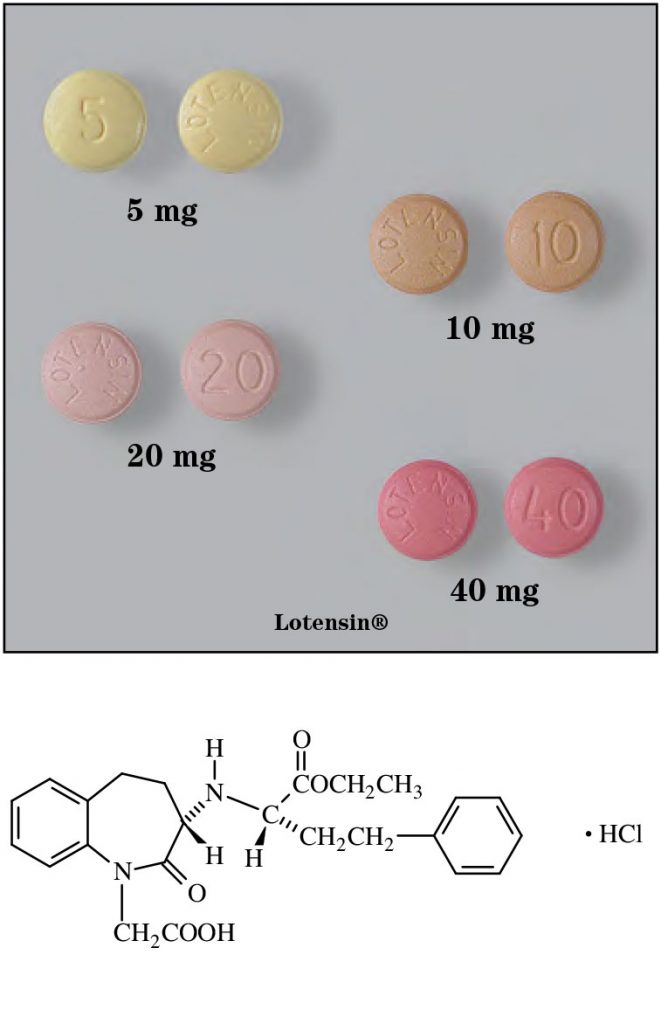
ben/ āz’ ə/pril
Brand Names: XLotensin®
- Generic Available
Common Dosage Forms:
- Tablets, immediate release: 0.25 mg, 0.5 mg, 1 mg, and 2 mg
- Tablets, extended release: 0.5 mg, 1 mg, 2 mg, and 3 mg
- Tablets, orally-disintegrating: 0.25 mg, 0.5 mg, 1 mg, and 2 mg
- Oral Solution Concentrate: 1 mg/mL
FDA Indications/Dosages:
- For the treatment of hypertension, alone or in combination with thiazide diuretics: Initially give 10 mg once daily. Maintenance dose is between 20 and 80 mg/day in one or two doses.
- Initial dose when using diuretics: Begin with 5 mg daily or temporarily discontinue diuretic therapy beginning 3 days before initial dose.
- Dosing in renal function impairment: Give 5 mg to a maximum of 40 mg daily in patients with CrCl of < 30 mL/min/1.73 m2.
Monitor:
K, BP, CrCl, WBC
Pharmacology/Pharmacokinetics:
Benazepril ‘s mechanism of action is thought to be due to its suppression of the renin-angiotensin-aldosterone system by competitively inhibiting the angiotensinconverting enzyme (ACE). ACE converts angiotensin I to angiotensin II, one of the most potent vasoconstrictors known. Inhibition of ACE decreases plasma angiotensin II which leads to decreased aldosterone secretion. The later may cause an increase in serum potassium. The net result is a decrease in peripheral arterial resistance. Benazepril is metabolized to the more active benazeprilat in the liver. Peak plasma levels of benazeprilat are reached in 1-2 hours. Protein binding is ≥95%. Half-life of benazeprilat is 10-11 hours. Elimination occurs predominately through the urine.
Drug Interactions:
Do not use with aliskiren. Indomethacin may decrease therapeutic effects. Capsaicin may increase the incidence of coughing. Because of potassium-sparing effect, use caution when given with potassium-sparing diuretics and potassium supplements. Use with trimethoprim may increase hyperkalemia. Lithium toxicity may occur when used together. Hypoglycemia may occur when used with sulfonylureas. Increased adverse effects may occur when used with other reninangiotensin system blockers or aliskiren.
Contraindications/Precautions:
Contraindicated with aliskiren. DO NOT USE DURING PREGNANCY. Use with caution in nursing women, in patients with impaired renal function, collagen vascular disease (may cause agranulocytosis), or aortic stenosis, and in patients undergoing surgery or anesthesia. Rare occurrences of angioedema and neutropenia have been seen in patients taking ACEIs. Patients should report to their physician any sign of facial swelling, difficulty in breathing, or infection (unexplained fever, sore throat). Pregnancy Category D.
Adverse Effects:
Mild adverse effects include cough, headache, dizziness, fatigue, and nausea. A potentially severe adverse effect is angioedema.
Patient Consultation:
- Do not discontinue medication unless otherwise directed by your physician.
- Avoid nonprescription cough, cold, and allergy medications unless otherwise directed.
- Avoid salt substitutes containing potassium and stay hydrated during therapy.
- Report any sign of facial swelling, difficulty in breathing, or infection (fever, sore throat) to your physician.
- Do not take if pregnant or if planning to become pregnant.
- Store in a cool, dry place away from sunlight and children.
- If a dose is missed, take it as soon as possible. If it is closer to the time of your next dose than the dose you missed, skip the missed dose and return to your dosing schedule. Do not double doses.